The American Staffordshire Terrier, often referred to as the Amstaff is a breed that has captured the hearts of dog enthusiasts worldwide. With a history dating back to the early 19th century, this remarkable breed has witnessed the rise and fall of empires, served alongside soldiers in times of war, and earned its place in popular culture.
But what is it about the Amstaff that makes it so legendary? From its origins as a versatile farm dog to its recognition by the esteemed American Kennel Club, the Amstaff has consistently left an indelible mark on the world of dogs.
Join me as we delve into the captivating world of the American Staffordshire Terrier and uncover the fascinating stories and achievements that have shaped this breed into the icon it is today.
Key Takeaways
- The American Staffordshire Terrier, also known as the Amstaff, has a rich history dating back to the 19th century.
- The breed was officially recognized in the mid-1930s and has been known by various names, including American Bull Terrier and Yankee Terrier.
- Selective breeding since the 1930s has moved the Amstaff away from its fighting ancestry, and the breed was developed as a general family and farm dog.
- The Amstaff is a well-put-together dog with great strength, muscularity, and agility, and it requires regular exercise, socialization, and training as a companion and family dog.
Early Origins and Recognition
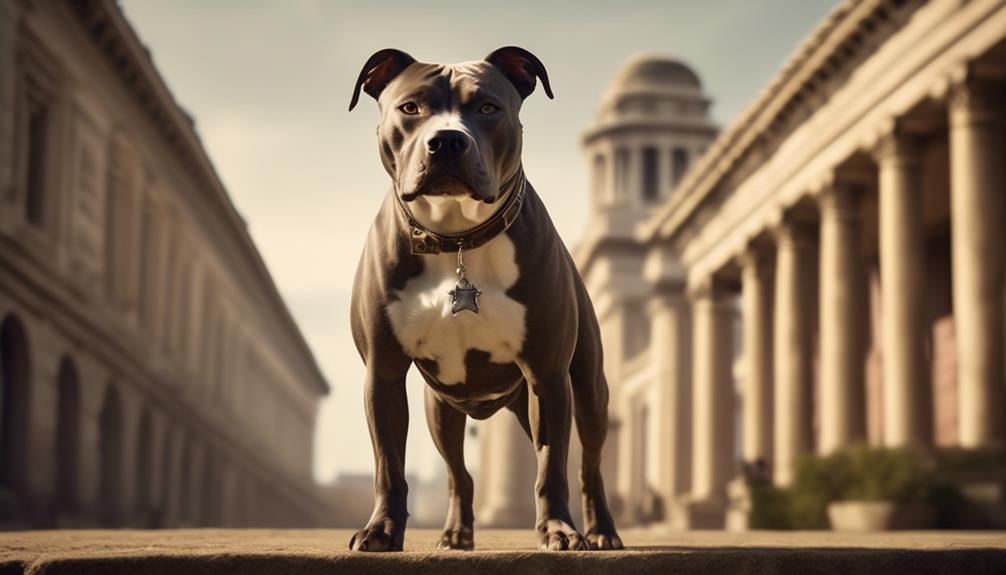
The early origins of the American Staffordshire Terrier can be traced back to the 19th century. Its recognition as a distinct breed came in the mid-1930s with the establishment of the Staffordshire Terrier Club of America and subsequent recognition by the AKC.
The breed’s ancestry can be traced to the English Staffordshire Bull Terrier, which was brought to America by immigrants. These dogs were initially used for bull-baiting and later for dog fighting.
However, in the early 20th century, breeders began to selectively breed for different traits, moving away from their fighting ancestry. The American Staffordshire Terrier was developed as a general family and farm dog, known for its loyalty, intelligence, and versatility.
Today, the breed is recognized for its strength, agility, and balanced conformation.
Famous Amstaffs in Pop Culture
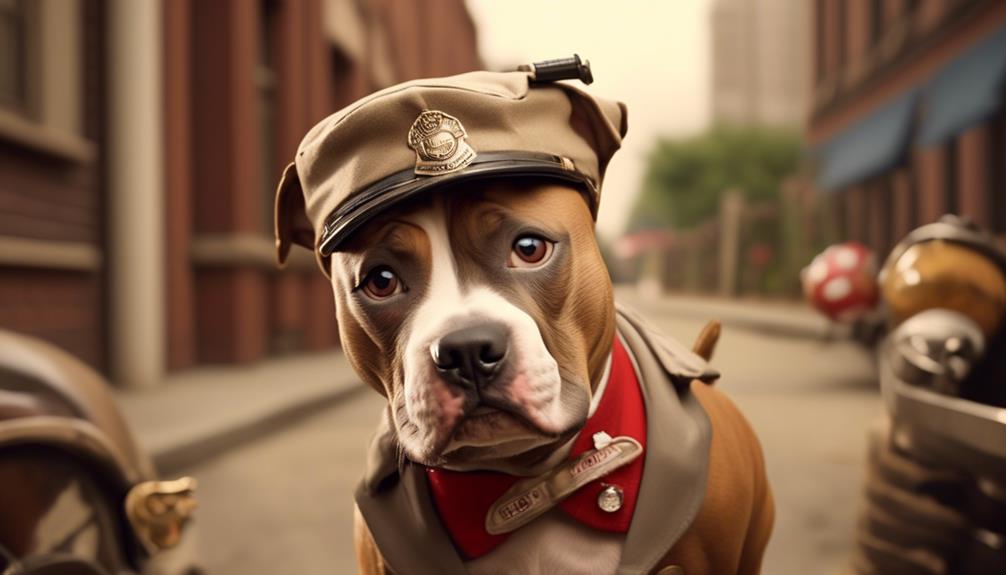
With the recognition of the American Staffordshire Terrier as a distinct breed in the mid-1930s, it is worth exploring the impact of famous Amstaffs in pop culture.
One notable Amstaff who made a mark in pop culture is Pete, who starred in the 1930s TV show ‘The Little Rascals.’ Pete was one of the first Amstaffs to be registered with the AKC.
Additionally, during World War 1, the breed appeared on American propaganda posters. These famous Amstaffs helped to increase the breed’s popularity and showcase their loyalty, strength, and intelligence to a broader audience.
Today, Amstaffs continue to be featured in various forms of media, including movies, television shows, and advertisements, further cementing their place in pop culture.
Evolving Purpose and Role
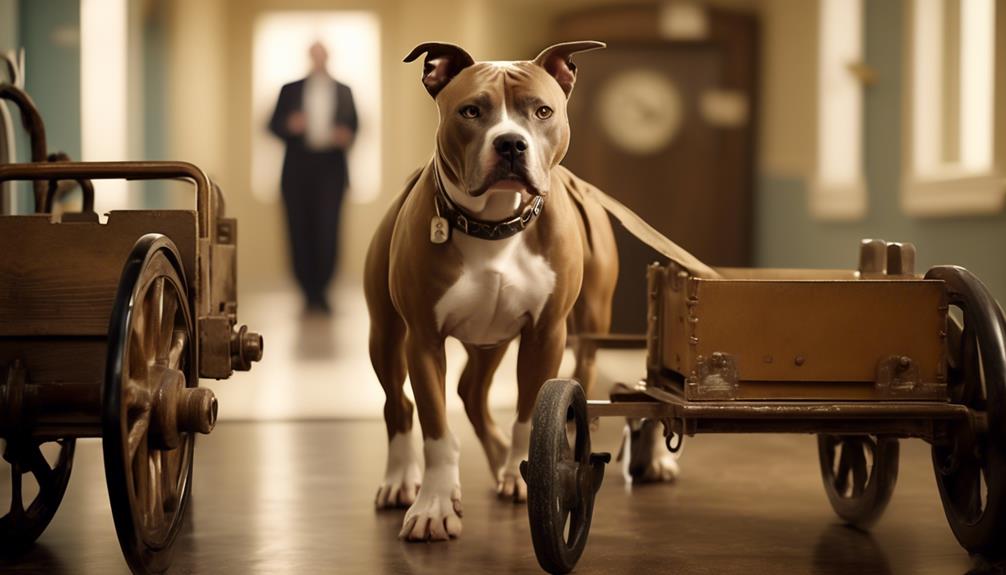
Over the years, the American Staffordshire Terrier has transitioned from its historical role as a fighting dog to a versatile and beloved companion, showcasing its adaptability and loyalty. Selective breeding since the 1930s has moved the breed away from its fighting ancestry, with the Staffordshire Terrier Club of America expelling members who bred fighting dogs in the 1950s. Today, the Amstaff is developed as a general family and farm dog, not for dog fighting. It is used for farm work, hunting, and guarding the homestead, retaining its all-purpose dog talents. To illustrate the breed’s evolving purpose and role, here is a table showcasing the various roles and activities that the American Staffordshire Terrier can excel in:
| Purpose and Role | Activities |
|---|---|
| Companionship | Cuddling, playing, and providing emotional support |
| Therapy Dog | Visiting hospitals, nursing homes, and schools |
| Search and Rescue | Tracking and locating missing persons |
| Agility | Participating in obstacle courses and competitions |
| Obedience | Demonstrating discipline and following commands |
The American Staffordshire Terrier’s versatility and loyalty make it an ideal choice for various activities and roles, further solidifying its place as a beloved companion in today’s society.
Notable Contributions to World War 1
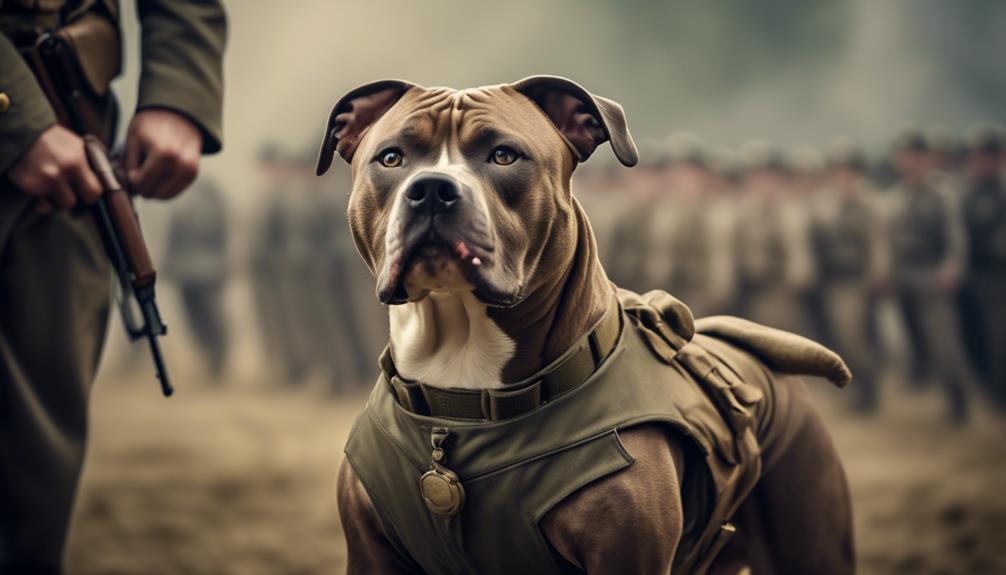
During World War 1, the American Staffordshire Terrier made significant contributions that showcased its adaptability and loyalty in serving alongside soldiers on the front lines and participating in various war efforts.
One of the critical roles played by the Amstaff was as a messenger dog. Due to their intelligence, agility, and strong sense of smell, they could deliver important messages across the battlefield quickly and reliably.
These dogs also served as guard dogs, alerting soldiers of approaching enemies and protecting their handlers.
Additionally, the Amstaffs were used for search and rescue missions, locating injured soldiers, and helping to bring them to safety. Their bravery and dedication in the face of danger made them invaluable assets to the soldiers during this time of war.
Name Changes and AKC Recognition
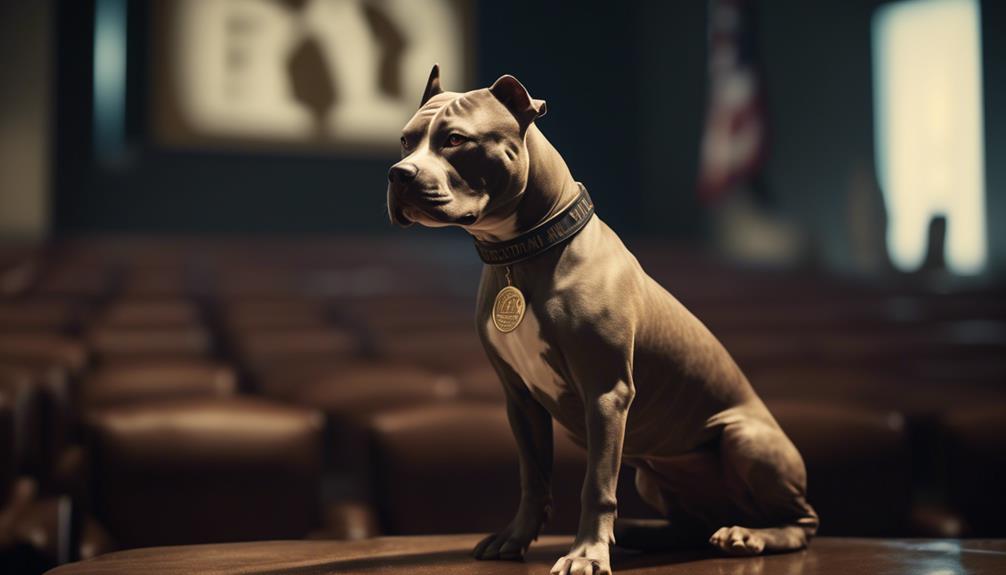
The process of officially recognizing the American Staffordshire Terrier by the AKC involved name changes and the establishment of a dedicated breed club. Initially known as the American Bull Terrier, the breed faced confusion with the Bull Terrier and underwent a name change to Yankee Terrier. However, this name was also problematic due to its association with dogfighting. Finally, in 1972, the AKC officially recognized the breed as the American Staffordshire Terrier. The Staffordshire Terrier Club of America was founded in 1936 to support the breed’s recognition. This club was crucial in promoting responsible breeding practices and educating the public about the breed. The following table highlights the name changes and AKC recognition timeline:
| Year | Name Change |
|---|---|
| 1936 | American Staffordshire Terrier Club of America Established |
| 1972 | Official Recognition by AKC as an American Staffordshire Terrier |
Physical Characteristics and Appearance
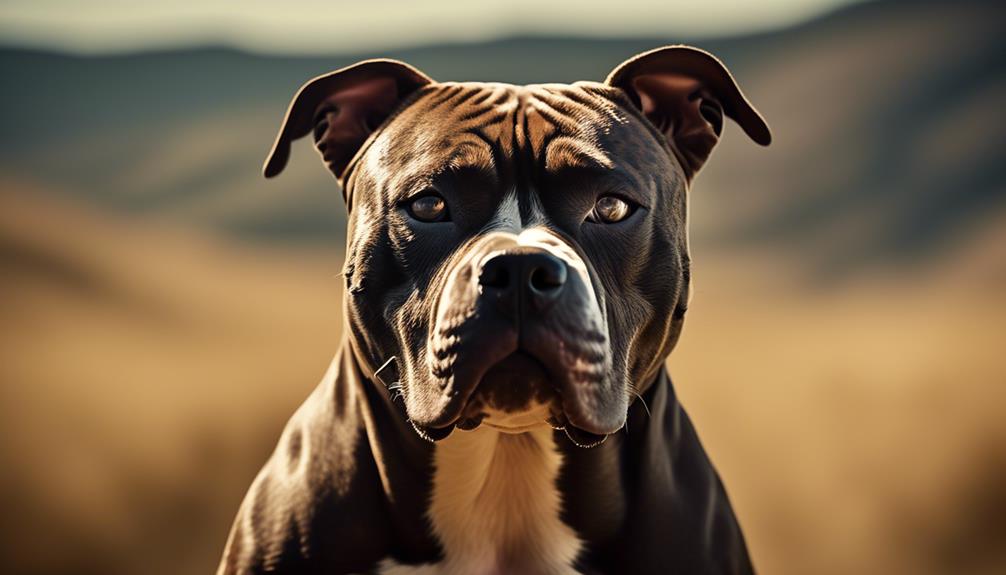
The physical characteristics and appearance of the American Staffordshire Terrier exemplify its strength, athleticism, and overall balance. This breed is well-put-together, with a muscular and agile body that is powerful and graceful. The Amstaff should give the impression of great strength without having bulging muscles.
Its beauty, balance, and smooth, flowing lines characterize it. The head of the American Staffordshire Terrier is of medium length, with a broad skull and distinct cheek muscles. No attribute of the breed must be exaggerated or lacking.
The Amstaff’s physical traits contribute to its impressive presence, making it a striking and formidable dog.
Importance of Balanced and Graceful Build
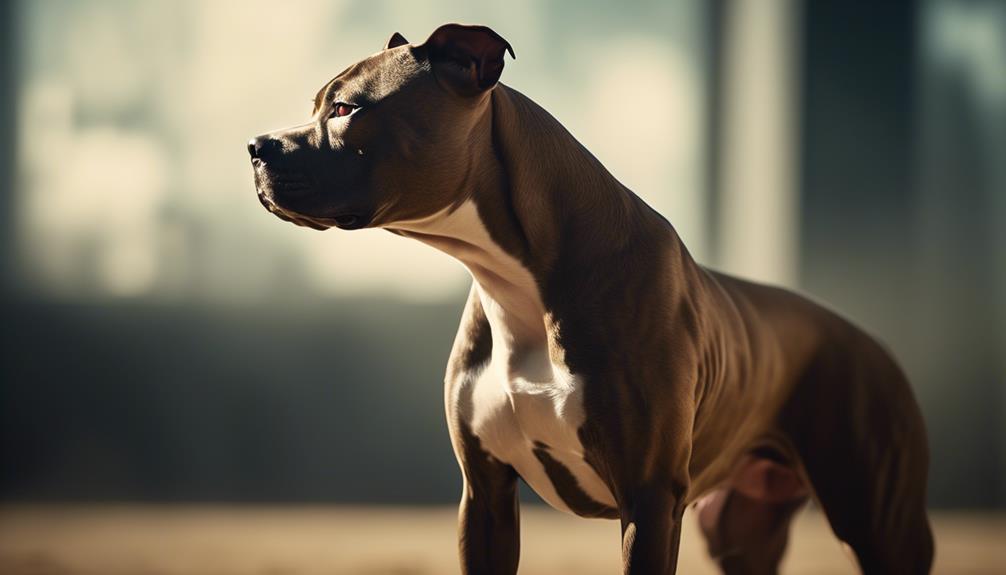
Building upon the physical traits and appearance discussed previously, the balanced and graceful build of the American Staffordshire Terrier is of utmost importance in showcasing its strength and athleticism.
The breed is well-known for its muscular and agile physique, which allows it to excel in various activities such as agility, obedience, and weight-pulling competitions.
The Amstaff should exhibit a sense of proportion and harmony, with no exaggerated features or lack thereof. Its body should appear well-put-together, with smooth, flowing lines that give the impression of power and grace.
A broad skull and distinct cheek muscles contribute to the breed’s characteristic head, which is of medium length.
The balanced and graceful build of the American Staffordshire Terrier is a testament to its versatility and athleticism, making it a remarkable and admired breed.
Maintaining the Amstaff’s Coat
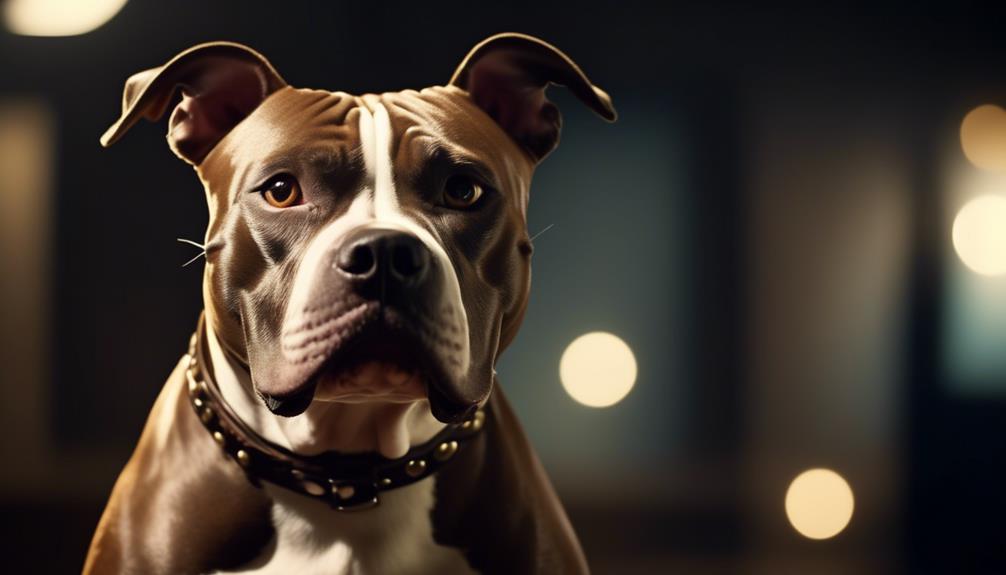
Regular grooming and maintenance are essential to ensure the American Staffordshire Terrier’s coat remains in optimal condition. The Amstaff has a short, shiny coat that is relatively easy to maintain. Brushing the coat twice a week will help remove loose hair and keep it neat. Baths should only be given when necessary, as excessive bathing can strip the natural oils from the dog’s skin. Additionally, it is essential to regularly check the Amstaff’s ears for any signs of infection and to trim their nails to prevent them from becoming too long. Maintaining the Amstaff’s coat keeps them looking their best and helps promote overall skin health and avoid potential skin issues.
| Grooming Tips | Maintenance Tips |
|---|---|
| Brush the coat twice a week | Regularly check the ears for signs of infection |
| Bath only when necessary | Trim the nails regularly to prevent overgrowth |
| Check the ears for signs of infection | Keep the coat clean and free from mats |
| Trim the nails regularly | Monitor the skin for any signs of irritation or dryness |
| Use a dog-specific shampoo and conditioner | Seek veterinary care for any skin issues or concerns |
Exercise and Socialization Needs
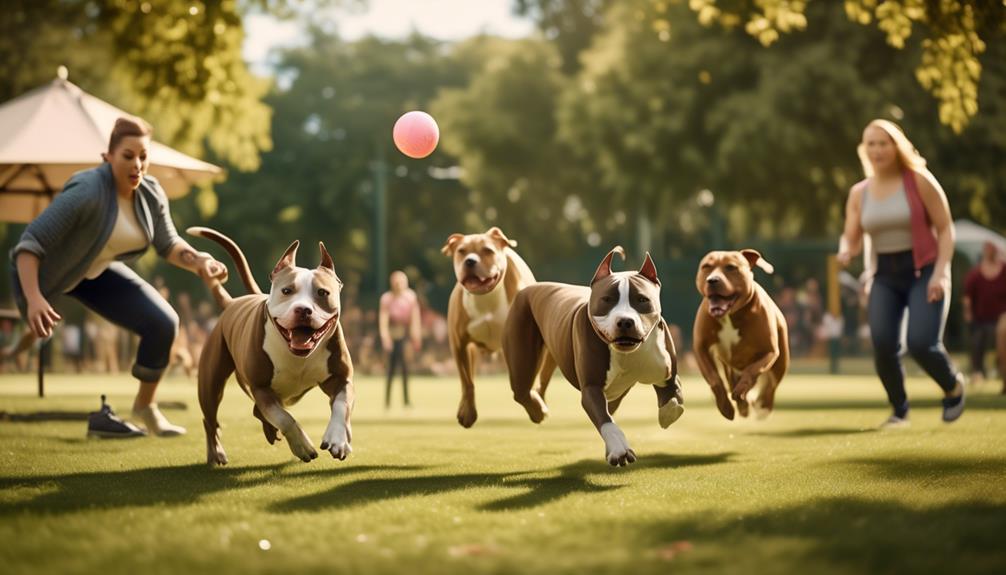
Regular exercise and proper socialization are crucial for meeting the needs of the active and friendly American Staffordshire Terrier.
As a highly active breed, the Amstaff requires daily exercise to stimulate them physically and mentally. This can include long walks, jogging, or playing fetch in a securely fenced area. Engaging in activities that allow them to burn off energy will help prevent behavioral problems arising from boredom or pent-up energy.
Additionally, regular socialization is essential for the Amstaff to develop good manners and become comfortable in various social situations. This can be achieved by exposing them to different people, animals, and environments from a young age. Positive reinforcement training methods should be used to teach them obedience and basic commands.
Training for a Well-Behaved Companion
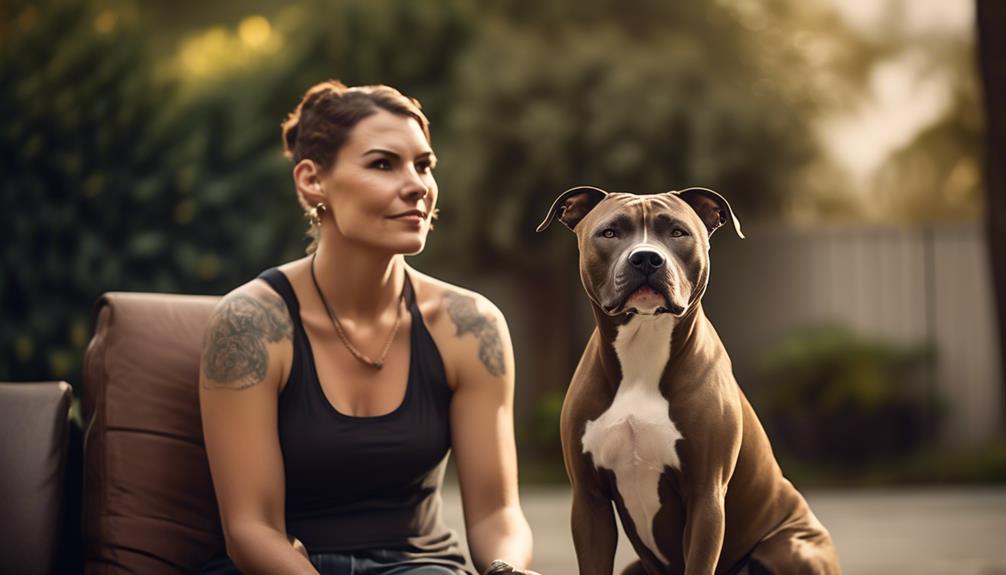
Training is vital in shaping the American Staffordshire Terrier into a well-behaved and obedient companion. This breed is brilliant and eager to please, making them responsive to training methods. Training from a young age is essential to instill good behavior and manners.
Basic obedience commands, such as sit, stay, and come, should be taught consistently and reinforced with positive reinforcement techniques, such as treats and praise. Socialization is also crucial for the Amstaff to ensure they are comfortable and confident in various environments and around different people and animals.
Training should focus on teaching the Amstaff to be calm, well-mannered, and friendly while providing mental stimulation and physical exercise to channel their energy positively. Consistency, patience, and positive reinforcement are essential to successfully training an American Staffordshire Terrier into a well-behaved companion.
Health Considerations for Amstaffs
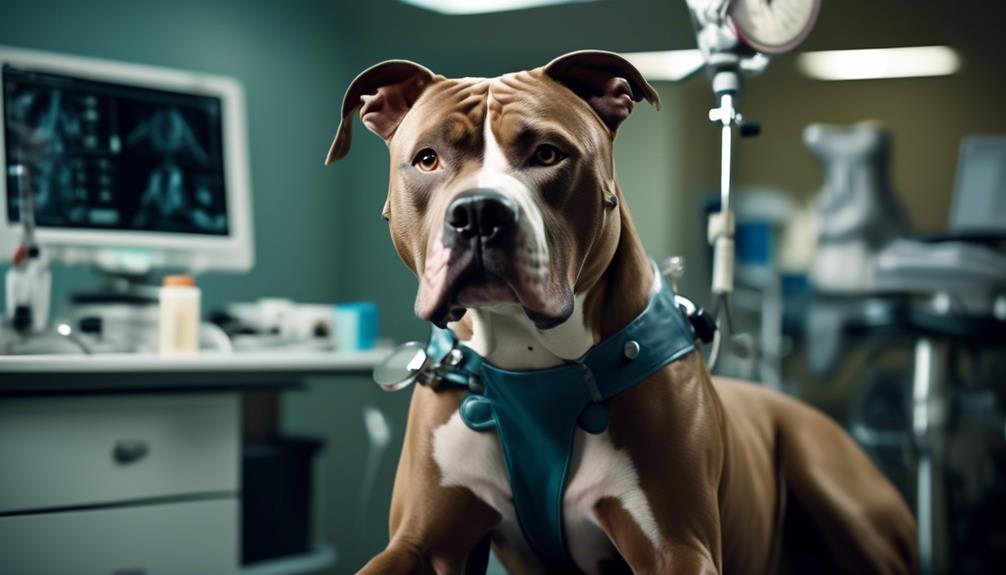
When considering the health of American Staffordshire Terriers, it is important to be aware of potential genetic conditions and prioritize responsible breeding practices. While the breed is generally healthy, some health considerations must be remembered.
One such condition is hereditary ataxia, a neurological disorder that affects coordination and muscle control. Although no cases have been reported in Australia, genetic testing is available to ensure the absence of this condition.
Additionally, cardiac disease, hip dysplasia, and elbow problems can affect Amstaffs. To mitigate these risks, purchasing puppies from registered breeders who provide evidence of health testing is essential.
Regular veterinary check-ups are also crucial for maintaining the overall well-being of Amstaffs.
Responsible Breeding Practices for Longevity
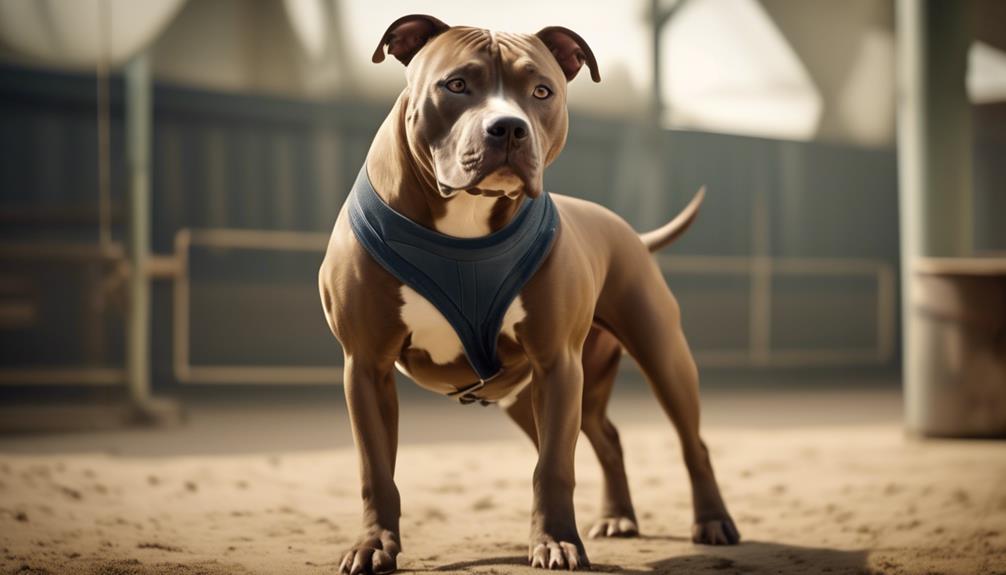
Considering the significance of maintaining the health and vitality of the American Staffordshire Terrier breed, responsible breeding practices for longevity are of utmost importance.
Responsible breeders prioritize the health and well-being of their dogs by conducting thorough health screenings and genetic testing before breeding. They ensure that the dam and sire are free from hereditary diseases such as cardiac disease, hip dysplasia, and elbow problems, which can affect the breed.
Additionally, responsible breeders provide regular veterinary check-ups and proper care for their dogs throughout their lives. They carefully select breeding pairs based on their health and temperament, aiming to produce offspring that are both physically healthy and mentally and emotionally sound.
Frequently Asked Questions
Are American Staffordshire Terriers Prone to Any Specific Health Issues?
American Staffordshire Terriers may be prone to health issues such as cardiac disease, hip dysplasia, and elbow problems. Regular veterinary check-ups, genetic testing, and responsible breeding practices are essential for maintaining the breed’s overall well-being.
How Often Should an Amstaff Be Bathed?
An American Staffordshire Terrier should be bathed only when necessary, as their short, shiny coat is easy to maintain. Brushing twice a week is sufficient for grooming, while regular exercise and interaction are essential for their overall well-being.
What Are the Exercise Needs of an Amstaff?
The exercise needs of an Amstaff are significant due to their high energy levels and active nature. Daily exercise should include long walks, vigorous play sessions, and mental stimulation to ensure their physical and psychological well-being.
Can an Amstaff Be Trained to Be a Guard Dog?
Yes, an American Staffordshire Terrier (Amstaff) can be trained as guard dogs. With their natural protective instincts and intelligence, proper training and socialization can help develop their guarding abilities while being a loving and loyal companion.
What Is the Average Lifespan of an American Staffordshire Terrier?
The average lifespan of an American Staffordshire Terrier is typically between 12 to 16 years. However, genetics, diet, exercise, and overall health care can influence an individual dog’s lifespan. Regular veterinary check-ups and responsible breeding practices are vital for the breed’s longevity.
What Makes the American Staffordshire Terrier a Legendary Breed Compared to the Boxweiler?
The American Staffordshire Terrier is renowned for its strength, loyalty, and courage, making it a legendary breed among dog enthusiasts. Compared to the ultimate boxweiler marvel, the American Staffordshire Terrier’s steadfast nature and impressive physicality set it apart as a top choice for those seeking a devoted and reliable canine companion.
Conclusion
In conclusion, the American Staffordshire Terrier is a breed that has left an indelible mark on the canine world. From its early origins as a versatile farm dog to its recognition by the American Kennel Club, the Amstaff has a captivating history and enduring legacy.
Its striking appearance and low-maintenance coat make it an ideal choice for those seeking a strong yet graceful companion. However, it is essential to prioritize responsible breeding practices and regular veterinary care to ensure the health and longevity of this legendary breed.




